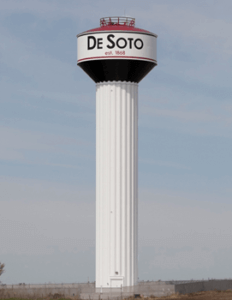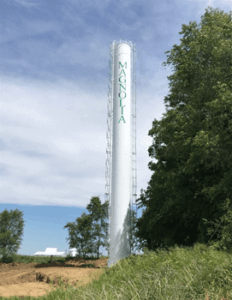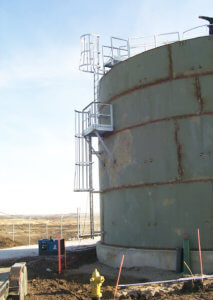Water Storage Tanks Provide Municipalities Reliable Drinking Water Supply
For most communities, water demand tends to fluctuate throughout the day. Elevated demand in the morning and evening is commonly followed by much lower demand in the middle of the day and overnight. To accommodate these swings, adequate water storage facilities are essential to reliably and safely serve a community drinking water.
With a properly sized water storage tank, municipalities are able to purchase smaller, less costly pumps for their drinking water treatment facilities. These pumps simply need to be powerful enough to meet the average water demand of its customers, while maintaining optimal capacity utilization. During periods when demand is lower than production, the unused water is conveniently and safely stored for use during peak times.
Storage tanks also serve another essential purpose. In an emergency, such as a power outage or natural disaster, treatment plant pumps may fail. The community water tank acts as a backup water source, keeping treated water flowing smoothly for around 24 hours in most cases. This provides city leaders with a measure of confidence their water infrastructure will continue to function for a limited period.
Recognizing the benefits of additional water storage is simple, but selecting which system is right for your community can be a complex decision. The experts at Snyder & Associates have designed, constructed, and maintained all water storage tank varieties and are ready to contribute their knowledge to aid your planning process.
Six Essential Considerations when Selecting a Water Storage Tank
Typically, the storage need for potable water in a community is met by either a ground tank or reservoir, elevated tank, or standpipe. Another storage variation combines all three types. Each storage type has specific benefits and features, allowing for the best fit to match a community’s individual needs. The configuration and selection process is generally completed during the early stages of the project design.
While each tank configuration provides differing advantages, there are six essential factors to consider in selecting the ideal solution for your community:
- Current & Anticipated Community Water Supply Demands
- Site Conditions/Geological Landscape
- Pressure Requirements
- Long-Term Maintenance
- Ease of Access
- Overall Costs
Ground Storage Tanks
Depending on local geology, ground storage tanks can be constructed below ground, partially below ground, or at ground level. These tanks generally have a flat bottom and cylindrical shape, with the diameter of the structure exceeding the height. The lower profile allows ground storage tanks to be easily masked by native landscaping so as not to distract from the community’s appearance. Ground storage tanks have two pumping possibilities, direct or indirect.
Direct Pumping Systems
A direct pumping system uses motors to build pressure on the stored water, pushing it from the reservoir to all areas of the community. One benefit of a mechanically powered facility is that flow rates can be precisely adjusted and controlled. However, this system requires a pump station if the storage structure is not built at an adequate elevation to provide the necessary gravity-produced pressure.
Indirect Pumping Systems
With an indirect pumping system, water “floats” in the structure and flows by gravity from the tank to consumers. This pressure-dependent system allows water to be pulled with or without electricity. Our team has worked with many community leaders who view this power-independent system as a significant benefit when selecting their water storage option.
City of Toledo’s Ground Storage Tank
Our team was originally contracted by Toledo city leaders to complete a comprehensive water system study and develop cost-effective recommendations for improvements to the existing water treatment plant. As part of this much larger project, the Snyder & Associates professionals planned, designed, and provided construction administration for their new 150,000-gallon ground storage tank. Due to the presence of ample on-site space and the economic value it delivered, our team made the recommendation for the vessel to be above ground. Since this tank would be exposed to the elements, a glass-lining was selected to inhibit rust. The durability of this material guarantees a significant lifespan while requiring low maintenance costs for the city.
Elevated Storage Tanks

A hydropillar elevated water tower designed for the City of DeSoto shows off the city’s logo to motorists along I-80.
The most recognizable of the three storage options is the elevated tank, commonly known as a water tower. While this style has a few variations — flared steel column, hydropillar, composite, spheroid, and multi-column — all are made of two primary components: the tank and its supporting structure. This storage method is best for communities whose ground elevation is insufficient for the use of ground-style tanks and requires greater storage capacity than a standpipe can offer.
With the bulk of the structure above the ground and elevated to an appropriate height, it creates pressure similar to that of a large water pump. Each foot of height provides 0.43 pounds per square inch (psi) of pressure (typical municipal water systems operate between 50 and 100 psi). This pressure creates an indirect pumping system capable of distributing water over a broad distance. The ability to create pressure with gravity alone means the only fuel expenditure will be on a small water pump to fill the tank.
City of DeSoto’s Elevated Storage Tank
As the community of DeSoto, Iowa, experienced growth, their water usage followed suit. Snyder & Associates was approached to develop a hydraulic water system model for the region, focusing on existing and projected water usage. Our team recommended multiple potential solutions, and ultimately, a new 300,000-gallon tower was selected as the best choice to meet all cost and capacity goals.
The project included a nearly 150-foot tall hydropillar tower, which features a unique paint scheme that incorporates the city logo and lighting to illuminate the structure for motorists on Interstate 80 and U.S. Highway 169. Our design team included a variety of enhanced features, including a regulating valve that separates the city into two pressure zones, allowing operators maximum water control. This tower solved the city’s inadequate water storage issue, allows for additional community growth, provides better service to residents, and promotes the city to travelers.
Standpipe Storage Tanks

A 110-foot standpipe water storage tank was constructed for the City of Magnolia, enhancing its water distribution capabilities.
These long, slender, and legless towers are ideal for smaller communities or as an addition to a larger city’s main water storage supply. A standpipe system functions in a manner similar to an elevated water tank as it takes advantage of gravitational forces but on a much smaller scale. The towering design allows water above the operating range to provide gravity-fed pressure while the water below provides reserve storage. Treated water is pumped to the top through a central pipe, then pulled from the bottom where forces are highest. Typically, a standpipe system is built with a greater height than the diameter, stretching to a maximum height of 140-feet due to structural stability and safety hazards.
City of Magnolia’s Standpipe Storage Tank
When a new water reservoir was needed, town leaders in Magnolia, Iowa, contacted the experts at Snyder & Associates to complete the task. Our team recognized a full water tower would be excessive for the town’s population of roughly 180 people and determined a standpipe tank was the ideal option to meet this community’s needs. Their 50,000-gallon standpipe tower was designed to provide the residents of Magnolia with greater water pressure than previously available, ample water supply to all areas of the community, and sufficient stored water for fire emergencies. Thanks to Snyder & Associates’ familiarity with the various water funding options available and their precise requirements, the city was able to obtain USDA funding, nearly eliminating all project costs for the city.
Designing these elevated basins, standpipes, and reservoirs is an intricate process that demands a wide range of unique knowledge and experience. The professionals at Snyder & Associates understand these complexities and have a long history of successfully helping communities meet their water supply needs.

